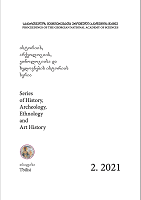ოსმალების მიერ დაპყრობილი საქართველოს ტერიტორიებისათვის შედგენილი დავთრების კლასიფიკაციის საკითხისათვის
For the Question of Clasification of the Registers (Defters) Compiled for the Territories of Georgia Conquered by the Ottomans
Author(s): Davit Sartania, Dali Nikolaishvili, Avtandil UjmajuridzeSubject(s): Cultural history, Archiving, Classification, Diplomatic history, Social history, The Ottoman Empire
Published by: საქართველოს მეცნიერებათა ეროვნული აკადემიის გამომცემლობა
Keywords: Gurjistan Vilayet; old Ottoman registers; the Great Register (defteri mufassal); Small Register (defteri icmal or defteri mucmel); Register of Changes (Ioklama);
Summary/Abstract: The Ottoman Empire, in its attempt to consolidate its dominance on the conquered territories, tried to wipe out the local rules and traditions and introduce Ottoman ones instead. For this purpose, specially assigned Ottoman officials used to thoroughly register the conquered territory (settled areas, population, types and rates of taxes, ownership of land and other real estate, etc.) and used to establish a new administration system and charge the local people with various Ottoman taxes. All these taxes were fixed in special books, the Registers (defteri). The Registers were made in two copies and were proved by the Sultan with a personal tughra (seal and signature). One copy of the Register was sent back to the officials on the occupied territory and another copy was kept at the Sultan’s royal court chancellery. As for the Registers, they came in various types, but the Registers compiled for Georgia, were of three types only: the Great Register (defteri mufassal), Small Register (defteri icmal or defteri mucmel) and Register of Changes (Ioklama). The Great Register gave detailed data about a certain area and its inhabitants. It gave the exact number of inhabitants of a concrete settlement, the types and amounts of taxes applied, the religious background of the population, etc. The Small Register showed the Ottoman officials’ ownership of the individual settlements of the same territory. The Ottoman officials of different ranks were given concrete settlements as remuneration and they owned a part of the taxes gained from them, with the remained portion of the taxes sent to the central treasury. With time, the owners of different settlements changed and this process is described in the latter Register, so called Register of Changes.
- Issue Year: 2021
- Issue No: 2
- Page Range: 192-211
- Page Count: 20
- Language: Georgian

